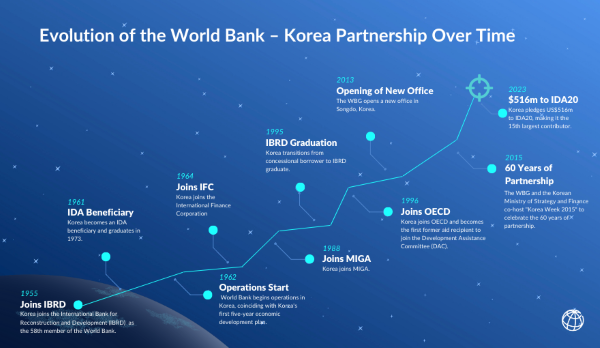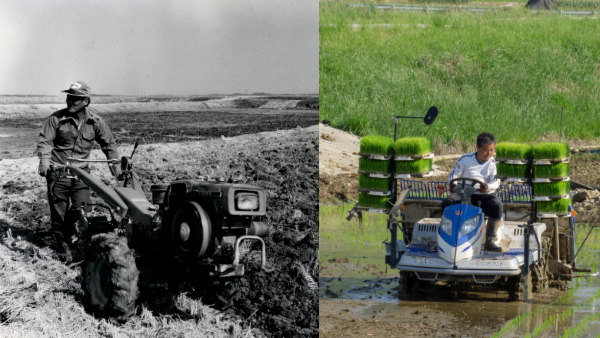The following story was originally published on 'Up Front' (WB Intranet News)

Sixty years ago, the Republic of Korea launched its first 5-year economic development plan. Korea's development plans became the blueprint to lift millions of Koreans out of poverty. Today, Korea is a high-income country and the tenth largest economy in the world.
The World Bank was there from the beginning. IDA's first lending to Korea in 1962 was $14 million for national railways. More projects followed on infrastructure, schools and agriculture. Within a decade, Korea had graduated from IDA, and only five years after that it became a financial contributor to IDA.
World Bank Managing Director of Operations Anna Bjerde, World Bank Vice President for East Asia and Pacific Manuela V. Ferro and Riccardo Puliti, IFC's Regional Vice President for Asia and the Pacific were in Seoul in May to celebrate the anniversaries of Korea's economic development plans and the World Bank office in Korea. Celebrating these events back-to-back mirrors the strong partnership between Korea and the Bank through Korea's development process.
"Korea has experienced an incredible journey of development in a relatively short period of time," Anna Bjerde said. "Korea has not only made enormous economic strides to improve the lives of all Koreans, but it has stepped up with development financing and knowledge to help people in many developing countries."
As an IBRD country, Korea made increasingly complex demands of the World Bank, asking for our support on industrial development, skills and education, and research and development. By the mid-1990s, Korea had also graduated from the IBRD and repaid its outstanding loans.

Photo: On May 17, 1971, the World Bank made a loan to the Korean Development Corporation in the amount of $30 million to help sustain the rapid growth of the Korean industry. Established in 1967 with the support of the World Bank and its affiliate, the International Finance Corporation (IFC), KDFC's principal objective is to promote the expansion of private productive enterprise in Korea, mainly by helping to meet the strong demand for medium-term and long-term finance. Among those present at the signing of the loan documents were seated, from left to right: Dr. Reignson Chen, Executive Director of World Bank for Korea; His Excellency Dong Jo Kim, Ambassador of Korea to the United States; Mr. J. Burke Knapp, Vice President of World Bank; and Mr. Ho Eul Whang, Minister, Embassy of Korea. Standing: Mr. Byong H. Shin, Alternate Executive Director of World Bank for Korea; and Mr. Y. L. Chang, Member of the Board of Directors of KDFC. (Credit / World Bank)
But perhaps Korea's success is simpler and more profound. Its success comes from a willingness to make decisions—decisions to invest in people, in infrastructure, and in public services—and to review the impact of those decisions, adjusting course if necessary.

Photo: (left) Archive image of farmer plow uncultivated land for future rice crops in this tideland area—Nam Yang area, Korea. (Credit: World Bank/Keum Yong Choi). (right) Korean farmer rides riding type power driven rice transplanter to seedling the green young rice onto the rice paddy field in Goseong city, South Korea. (Credit: The Mariner 4291 / Shutterstock)
Because of the speed with which Korea grew, many of the people who were making those decisions are still around today. They can tell us why they did things the way they did; what were their successes and failures. This demystifies the development process. It is a powerful example for countries that face development challenges today that progress is within their reach too.
Ten years ago, Korea supported the World Bank to set up an office in Incheon, just outside Seoul. Our staff there work with current and former Korean officials, academics and business people to make their practical development experience available to decision makers in other countries.
Korea really has traveled the full gamut of development, from 60 percent of the population living in extreme poverty in 1955, to a high-income country today. It is an influential and growing supporter of IDA, and of other World Bank financing mechanisms. But, most importantly, it is a deep and generous source of practical development knowledge for the rest of the world.
